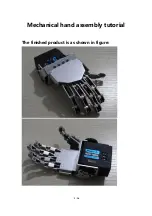
15 – Cricket Robot Documentation
Batteries
Cricket uses standard AA batteries. The batteries will last about 1 -2 hours of operation
before needing to be replaced. Rechargeable batteries are an economical alternative to
alkaline cells. Battery power enters the controller board through a terminal block at the
rear of the controller. The on-off switch at the rear of the controller turns Cricket on and
off.
Speaker and Sound Generation
The Arduino microcontroller has the ability to
make sounds of various frequencies and
duration. The Cricket program makes
extensive use of this ability using a small
speaker to generate many different sound
effects. I would be an interesting experiment to
modify some of the “Sound” commands in the
Cricket program and see how it affects
Cricket’s voice. The speaker is glued to the
chassis face down which may seem odd but
the chassis acts as a sound board much like
the body of a guitar. If you follow the directions
you will be surprised how loud the Cricket sounds are.
Infrared Remote Receive
The remote control uses infrared light to
communicate with Cricket. The black part with a
bubble on the controller board (IR1) is an IR
receiver, which can detect the remote control
signals. The detected signal is converted into a
command which the program software uses to
override Crickets autonomous behavior.
Speaker
Summary of Contents for Arduino Walking Robot
Page 1: ...Revision 1 0B Copyright 2015 Cricket Robot Documentation...
Page 8: ...8 Cricket Robot Documentation Top View...
Page 9: ...9 Cricket Robot Documentation Bottom View...
Page 10: ...10 Cricket Robot Documentation Front View...
Page 90: ...90 Cricket Robot Documentation Appendix A Schematics...
Page 91: ...91 Cricket Robot Documentation...
Page 92: ...92 Cricket Robot Documentation Appendix B Parts List...
Page 93: ...93 Cricket Robot Documentation...
Page 94: ...94 Cricket Robot Documentation Appendix C PC Board Layout All Layers Parts Layout...












































